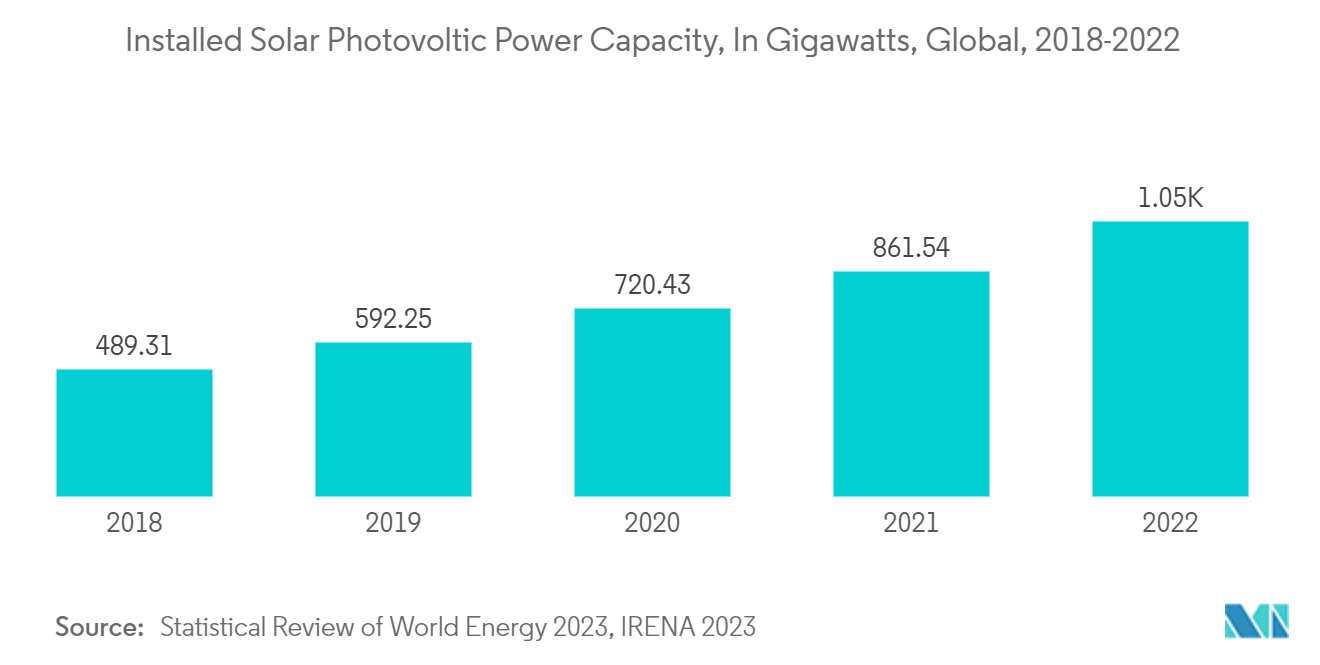Market Trends of Conductive Ink Industry
Growing Demand from Photovoltaic Segment
- Conductive ink, owing to its high conductivity, low sheet resistivity, excellent adhesion to indium tin oxide and cadmium tin oxide, superior printing resolution, and low curing temperature, has been widely used in solar cell panels.
- Moreover, the solar (photovoltaic) industry has been facing significant pressures to both reduce raw materials costs and increase production efficiency in order to compete with traditional grid power systems. In such a scenario, the usage of conductive inks acts as a viable solution for the industry.
- Globally, the photovoltaic (PV) industry has been increasing at a steady pace, with China leading the global PV market in terms of capacity additions through the current and future years.
- Among all the renewable energy sources, solar PV and wind energy accounted for the fastest growth across the world. Both renewable energy sources contribute two-thirds of the renewable energy generation annually.
- According to the Statistical Review of World Energy 2023, the world's installed photovoltaic power capacity stood at 1053.12 gigawatts, registering an increase of 22.2% in 2022 as compared to 861.54 gigawatts in 2021.
- According to the International Energy Agency, solar PV generation increased by a record 270 terawatt hours (TWh) in 2022, up around 26% from last year and reaching almost 1 300 TWh. It has surpassed wind energy in terms of generation growth of all the renewable technologies in 2022.
- Overall, all such factors are expected to drive the market for conductive ink in photovoltaic applications through the years to come.

Asia-Pacific Region to Dominate the Market
- The Asia-Pacific region, owing to countries such as China, India, and Japan, has emerged as the leading consumer of conductive inks in the global market.
- China leads the photovoltaic capacity additions in both the Asia-Pacific and the global market. It is expected that most of the capacity addition through the coming years will come from China, India, and other Asia-Pacific countries.
- With the increasing demand for flexible and printed electronics, conductive inks are being increasingly used in the production of printed circuit boards (PCBs), sensors, and antennas.
- Taiwan is a leading country in the PCB industry. According to the Taipei Printed Circuit Association (TPCA), the printed circuit board industry has temporarily led the global market with a 33.9% market share. In 2022, the output volume of printed circuit boards in Taiwan reached about 625 million square feet.
- Taiwan may maintain its technological lead for 3-5 years if the government establishes a global hub for advanced PCB fabrication and pursues autonomy in PCB material supply.
- Additionally, China leads almost the entire value chain of the electronics production market globally and is also significantly investing in finding new ways to rapidly develop the miniaturization of electronics products.
- According to the China Electricity Council, as of 2022, China has an installed solar power capacity of over 390 gigawatts. China has made enormous strides in building its solar power capacity within the past decade, growing cumulative capacity from only 4.2 gigawatts in 2012 to 392.6 gigawatts in 2022.
- Further, to bring in a green revolution in India, the Indian government has set an ambitious target of having 500 GW of installed renewable energy by 2030, which includes the installation of 280 GW of solar power, which in turn will increase the demand for conductive inks in the country.
- Overall, such factors are expected to drive the market for conductive ink in the Asia-Pacific region through the years to come.


